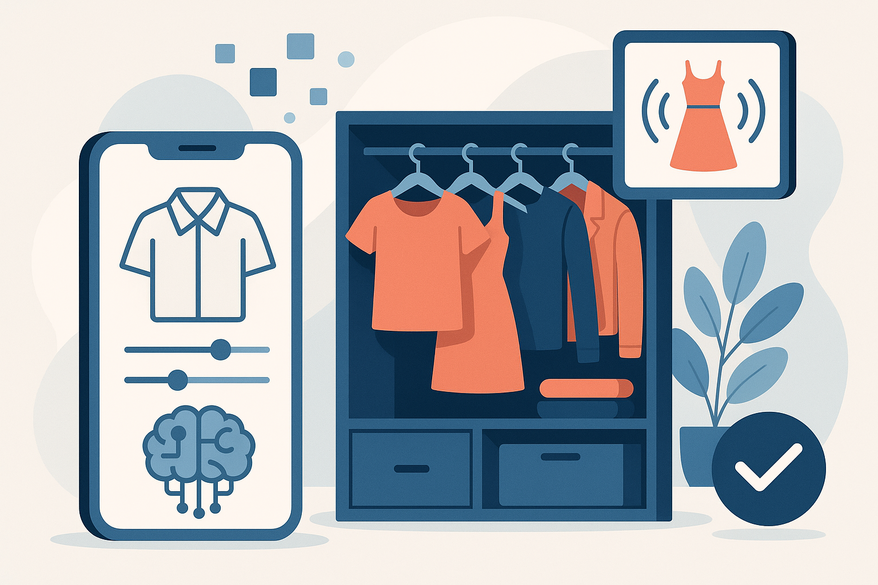The Ultimate AI Closet Organizer: Transform Your Wardrobe with Smart Technology
Discover the ultimate AI closet organizer to optimize wardrobe management with smart technology. Personalize your style and simplify closet upkeep.

Estimated reading time: 8 minutes
Key Takeaways
- AI closet organizers use machine learning and computer vision to offer personalized outfit and storage suggestions.
- Space optimization relies on 3D modeling and cargo-packing algorithms to maximize every inch of storage.
- Automation features track wear patterns, flag duplicates, and rotate seasonal items for streamlined maintenance.
- Leading platforms—from Coohom to Microsoft 365 AI—provide visualization, inventory tagging, and virtual styling.
- Implementing an AI closet organizer involves six steps: inventory input, dimension setup, AI customization, application, utilization, and iteration.
Table of Contents
- How AI Closet Organizer Enhances Closet Organization
- Overview of Available AI Closet Organizer Tools
- Step-by-Step Guide to Implementing an AI Closet Organizer
- Mini-Checklist for Maximizing Benefits
- Case Studies & User Experiences
- Future Trends in AI Closet Organizer
- Conclusion
An AI closet organizer is a digital tool or app that uses artificial intelligence to help users manage, categorize, and optimize their wardrobe and closet space. By combining computer vision, machine learning, and intuitive interfaces, this smart wardrobe system evaluates your clothing inventory and spatial layout. Early on, these digital closet management platforms began as simple cataloging apps. Today, advanced AI technologies analyze fabric types, track wear patterns, and even suggest seasonal rotations.
To see AI-driven style and wardrobe insights in action, watch how Maxx Report simplifies organization in this short demo:
These systems leverage AI algorithms to analyze user preferences, closet inventory, and spatial dimensions, generating personalized storage and outfit recommendations. Whether you’re a fashion-forward professional or a busy parent, an AI closet organizer streamlines outfit planning and closet maintenance.
How AI Closet Organizer Enhances Closet Organization
AI-driven closet management offers three core advantages—tailored advice, efficient space use, and hands-off upkeep. By combining these benefits, an AI closet organizer becomes a time-saving, efficiency-boosting solution.
1. Personalized recommendations
- Definition: AI algorithms assess your clothing stock, style preferences, and daily habits to propose custom storage layouts and outfit pairings.
- How it works: The system tracks which items you wear most, learns your color palette, and factors in calendar events (e.g., business meetings or gym days) to craft outfits.
- Benefits:
- Reduces decision fatigue by suggesting outfits each morning.
- Encourages new style combinations you might not consider on your own.
- Adapts over time as your tastes evolve.
- Real-world example: Users report a 30% drop in “closet indecision” time by relying on AI-suggested ensembles.
2. Space optimization
- Definition: AI analyzes closet dimensions and contents via virtual 3D modeling to suggest layouts that maximize every inch of storage.
- How it works: Using room-scanning features or manual measurements, the tool creates a digital twin of your closet. Then it runs packing algorithms—similar to cargo loading—to place shelves, drawers, and hangers in the most space-efficient configuration.
- Benefits:
- Fits more items without overcrowding.
- Ensures easy access to high-frequency pieces.
- Integrates foldable sections for shoes, accessories, and seasonal gear.
3. Automation
- Definition: Continuous tracking of wardrobe inventory, categorizing garments by usage frequency, and alerting for duplicates or unworn items to reduce clutter.
- How it works: Barcode scanning or image recognition tags each item. AI then updates wear counts automatically when you log an outfit.
- Benefits:
- Prevents you from buying duplicates or forgetting pieces in the back of your closet.
- Sends reminders to rotate seasonal items.
- Flags stained or damaged items for cleaning or donation.
Overview of Available AI Closet Organizer Tools
Here’s a comparative look at leading smart closet platforms—ranging from 3D space planners to virtual stylists.
Coohom
- Features:
- 3D closet visualization for realistic spatial planning.
- Space analysis with shelf and hanging recommendations.
- Customizable storage solutions like modular cubbies.
- Usability:
- Drag-and-drop interface with real-time space calculation.
- Virtual try-on feature to preview outfits.
- Integrates LSI capabilities like “wardrobe simulator.”
Smart Closet (MIT concept)
- Features:
- AI-powered inventory management with image tagging.
- Personal stylist suggestions based on body type and lifestyle.
- Mix-and-match outfit planner that shuffles items for fresh looks.
- Innovation:
- Seamless cloud-based storage for remote access.
- Learns user feedback to refine style algorithms.
Microsoft 365 AI Tools
- Features:
- Custom prompts for organizing layout, folding, and storage best practices.
- Integration with Outlook calendar to plan outfits around meetings.
- Step-by-step closet makeover guides using Excel floor plans.
- Innovation:
- Unified workflow across Word, Excel, and Teams.
- Leverages Microsoft Graph for personalized reminders.
AI Outfit Planning Apps
- Features:
- Automated outfit suggestions based on weather APIs.
- Rapid wardrobe management via mobile-first design.
- Daily lookbook creation in seconds.
- Usability:
- Push notifications for upcoming outfit reminders.
- Closet scanning through smartphone camera.
Step-by-Step Guide to Implementing an AI Closet Organizer
- Input Your Inventory
- Photograph, scan, or manually list all clothing and accessories.
- Use built-in image recognition to auto-tag fabrics and colors.
- Confirm or correct AI guesses for best accuracy.
- Provide Closet Specifics
- Enter exact dimensions: width, height, and depth.
- Specify storage preferences: hanging rods, shelves, drawers.
- Note special zones for shoes, bags, or seasonal items.
- AI Customization
- Grant permission for the AI to analyze your items, personal style, and space.
- Review initial organization and outfit suggestions.
- Provide feedback (e.g., “Group all black tees together”) to refine results.
- Apply Organization Recommendations
- Physically rearrange garments by frequency of use, color palette, or outfit potential.
- Install suggested modular units or shelf dividers.
- Label sections (e.g., “Work,” “Casual,” “Seasonal”).
- Utilize Automated Features
- Enable notifications for unworn items.
- Activate duplicate alerts to curb unnecessary purchases.
- Try suggested outfit combos before important events.
- Review & Iterate
- Update inventory with new purchases or donations.
- Adjust layouts each season or when your style changes.
- Track metrics like “outfits worn per week” to measure efficiency gains.
Mini-Checklist for Maximizing Benefits
- Digitize entire wardrobe with clear images.
- Accurately measure and log closet dimensions.
- Tag items as “worn,” “new,” or “donated.”
- Follow AI-suggested outfits daily.
- Conduct seasonal “AI refresh” of organization.
Case Studies & User Experiences
Real-world users report quantifiable gains after adopting AI-powered wardrobe solutions:
- Reduced clutter
By tracking actual wear frequency, users identify 20–30% of items for donation or resale. Cleaner closets free up physical and mental space. - Faster morning routines
Users save an average of 10 minutes per day by relying on AI-suggested outfits. Avoid wardrobe indecision and last-minute changes. - Personalized style improvement
Testimonials highlight boosted confidence when AI tailors looks to body shape and lifestyle, reducing impulse buys of similar pieces by 25%.
Future Trends in AI Closet Organizer: Smart Home Integration & Privacy
- Smart home integration
Voice assistants (e.g., Alexa, Google Home) suggest outfits based on weather forecasts or calendar events. Automated lighting cues highlight specific wardrobe zones. - Advanced personalization
Predictive analytics recommend wardrobe updates, from new season essentials to resale opportunities. AI mixing and matching expands into AR try-ons and virtual fashion shows. - Privacy & cost considerations
Data-security challenges: ensuring personal style data remains encrypted and private. Premium feature pricing: subscription tiers for advanced analytics vs. basic space planning.
Conclusion
AI closet organizers deliver unparalleled wardrobe efficiency through personalized recommendations, optimized space usage, and automated inventory management. These smart wardrobe solutions eliminate daily wardrobe stress, foster sustainable shopping habits, and transform closet maintenance into a simple, guided process.
For a curated capsule wardrobe approach, see our capsule wardrobe checklist guide. To compare top AI styling apps, check out our best AI styling apps of 2025.
FAQ
- What is an AI closet organizer?
An AI closet organizer is a digital platform that uses artificial intelligence to catalog your wardrobe, suggest outfits, optimize space, and automate maintenance tasks. - How accurate are the AI recommendations?
Accuracy improves over time as the system learns your wear patterns, style preferences, and feedback. Most users report highly relevant outfit suggestions after a few weeks of use. - Is my wardrobe data secure?
Leading AI closet organizers employ encryption, secure cloud storage, and privacy controls to ensure your personal style data remains confidential.





